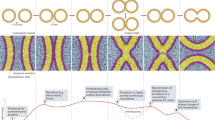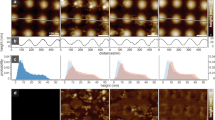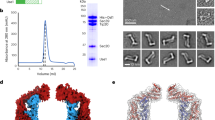Abstract
SNARE (soluble NSF attachment protein receptor) proteins assemble into a stable complex essential for vesicle–membrane fusion. To further understand SNARE function we have used solution nuclear magnetic resonance (NMR) spectroscopy to characterize three assembly states of a yeast SNARE complex: first, the 'closed' conformation of Sso1; second, the binary complex of Sso1 and Sec9; and third, the ternary complex of Sso1, Sec9 and Snc1. Sec9 and Snc1 are unstructured in isolation. Sso1 likely consists of a four helix bundle formed by part of the C–terminal Hcore domain and the N–terminal HAHBHC domain, and this bundle is flanked on both sides by large flexible regions. Sso1 switches to an 'open' state when its Hcore domain binds Sec9. Conformational switching of the Hcore domain, via HAHBHC, may provide a key regulatory mechanism in SNARE assembly. Formation of binary and ternary complexes induces additional α–helical structure in previously unstructured regions. Our data suggest a directed assembly process beginning distal to the membrane surfaces and proceeding toward them, bringing membranes into close proximity and possibly leading to membrane fusion.
This is a preview of subscription content, access via your institution
Access options
Subscribe to this journal
Receive 12 print issues and online access
$189.00 per year
only $15.75 per issue
Buy this article
- Purchase on Springer Link
- Instant access to full article PDF
Prices may be subject to local taxes which are calculated during checkout





Similar content being viewed by others
References
Ferro–Novick, S. and Jahn, R. Nature 370, 191–193 (1994).
Weimbs, T. et al. Proc. Nat. Acad. Sci. USA 94, 3046– 3051 (1997).
Terrian, D.M. & White, M.K. Eur. J. Cell. Biol. 73, 198–204 (1997).
Rossi, G., Salminen, A., Rice, L.M., Brunger, A.T. & Brennwald, P. J. Biol. Chem. 272, 16610– 16617 (1997).
Bennett, M.K. Curr. Opin. Cell. Biol. 7, 581–586 (1995).
Calakos, N., Bennett, M.K., Peterson, K.E. & Scheller, R.H. Science 263, 1146–1149 ( 1994).
Lin, R.C. & Scheller, R.H. Neuron 19, 1087–1094 (1997).
Fasshauer, D., Eliason, W.K., Brunger, A.T. & Jahn, R. Biochemistry 37, 10354–10362 ( 1998).
Poirier, M.A. et al. J. Biol. Chem. 273, 11370– 11377 (1998).
Sutton, R.B., Fasshauer, D., Jahn, R. & Brunger, A.T. Nature 395, 347–353 (1998).
Fernande, I. et al. Cell 94, 841–849 (1998).
Nicholson, K. L. et al. Nature Struct. Biol. 5, 793– 802 (1998).
Fasshauer, D., Otto, H., Eliason, W.K., Jahn, R. & Brunger, A.T. J. Biol. Chem. 272, 28036– 28041 (1997).
Fasshauer, D., Bruns, D., Shen, B., Jahn, R. & Brunger, A.T. J. Biol. Chem. 272, 4582– 4590 (1997).
Rice, L.M., Brennwald, P. & Brunger, A.T. FEBS Lett. 415, 49– 55 (1997).
Schulman, B.A., Kim, P.S., Dobson, C.M. & Redfield, C. Nature Struct. Biol. 4, 630–634 ( 1997).
Schwalbe, H. et al. Biochemistry 36, 8977– 91 (1997).
Wishart, D.S., Bigam, C.G., Holm, A., Hodges, R.S. & Sykes, B.D. J. Biomol. NMR 5, 67– 81 (1995).
Hanson, P.I., Roth, R., Morisaki, H., Jahn, R. & Heuser, J.E. Cell 90, 523–535 (1997).
Hanson, P.I., Otto, H., Barton, N. & Jahn, R. J. Biol. Chem. 270, 16955–16961 (1995).
Aalto, M.K., Ronne, H. & Keranen, S. EMBO J. 12, 4095– 4104 (1993).
Hata, Y., Slaughter, C.A. & Südhof, T.C. Nature 366, 347– 351 (1993).
Garcia, E.P., McPherson, P.S., Chilcote, T.J., Takei, K. & De Camilli, P. J. Cell. Biol. 129 , 105–120 (1995).
Pevsner, J., Hsu, S.C. & Scheller, R.H. Proc. Natl. Acad. Sci. USA 91, 1445–9 (1994).
Kay, L.E., Keifer, P. & Saarinen, T. J. Am. Chem. Soc. 114, 10663– 10665 (1992).
Live, D.H., Davis, D.G., Agosta, W.C. & Cowburn, D. J. Am. Chem. Soc. 106, 1939–1943 (1986).
Marion, D. et al. Biochemistry 28, 6150– 6156 (1989).
Driscoll, P.C., Clore, G.M., Marion, D., Wingfield, P.T. & Gronenborn, A.M. Biochemistry 29, 3542– 3556 (1990).
Bartels, C., Xia, T.H., Billeter, M., Guntert, P. & Wûthrich, K. J. Biomol. NMR 6, 1– 10 (1995).
Zhang, O., Kay, L.E., Olivier, J.P. & Forman–Kay, J.D. J. Biomol. NMR 4, 845–858 ( 1994).
Acknowledgements
The authors thank D. Fasshauer, L. Gonzales, R. Jahn, R.B. Sutton and S. Stallings for stimulating discussions; M. Cocco, K. Gardner and L.E. Kay for help with NMR methodology, K. Zilm for gracious access to Yale's Varian 800 MHz spectrometer, and P. Brennwald for a construct of Snc1. Support by the National Institutes of Health to A.T.B., an HHMI predoctoral fellowship to L.M.R., and a Hitchings Elion Fellowship from the Wellcome Fund to K.M.F. is gratefully acknowledged.
Author information
Authors and Affiliations
Corresponding author
Rights and permissions
About this article
Cite this article
Fiebig, K., Rice, L., Pollock, E. et al. Folding intermediates of SNARE complex assembly. Nat Struct Mol Biol 6, 117–123 (1999). https://doi.org/10.1038/5803
Received:
Accepted:
Issue Date:
DOI: https://doi.org/10.1038/5803



